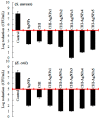Biogenic Nanoparticle‒Chitosan Conjugates with Antimicrobial, Antibiofilm, and Anticancer Potentialities: Development and Characterization
- PMID: 30791374
- PMCID: PMC6406235
- DOI: 10.3390/ijerph16040598
Biogenic Nanoparticle‒Chitosan Conjugates with Antimicrobial, Antibiofilm, and Anticancer Potentialities: Development and Characterization
Abstract
In the 21st century, with ever-increasing consciousness and social awareness, researchers must tackle the microbial infections that pose a major threat to human safety. For many reasons, the emergence/re-emergence of threatening pathogens has increased and poses a serious challenge to health care services. Considering the changing dynamics of 21st-century materials with medical potentialities, the integration of bioactive agents into materials to engineer antibacterial matrices has received limited attention so far. Thus, antimicrobial active conjugates are considered potential candidates to eradicate infections and reduce microbial contaminations in healthcare facilities. In this context, eco-friendly and novel conjugates with antimicrobial, antibiofilm, and anticancer potentialities were developed using biogenic silver nanoparticles (AgNPs) from Convolvulus arvensis (C. arvensis) extract and chitosan (CHI). A range of instrumental and imaging tools, i.e., UV-Vis and FTIR spectroscopy, scanning electron microscopy (SEM), transmission electron microscopy (TEM), energy-dispersive spectroscopy (EDX), and X-ray diffraction (XRD), were employed to characterize the freshly extracted C. arvensis AgNPs. Biogenic AgNPs obtained after a 24-h reaction period were used to engineer CHI-based conjugates and designated as CHI‒AgNPs1 to CHI‒AgNPs5, subject to the C. arvensis AgNPs concentration. After the stipulated loading period, 92% loading efficiency (LE) was recorded for a CHI‒AgNPs3 conjugate. Gram+ and Gram- bacterial isolates, i.e., Staphylococcus aureus, and Escherichia coli, were used to test the antibacterial activities of newly developed CHI‒AgNPs conjugates. In comparison to the control sample with bacterial cell count 1.5 × 10⁸ CFU/mL, a notable reduction in the log values was recorded for the CHI‒AgNPs3 conjugate. The antibiofilm potential of CHI‒AgNPs conjugates was tested against Pseudomonas aeruginosa. Moreover, the CHI‒AgNPs3 conjugate also showed substantial cytotoxicity against the MCF-7 (breast cancer) cell line. In summary, the newly engineered CHI‒AgNPs conjugates with antibacterial, antibiofilm, and anticancer potentialities are potential candidate materials for biomedical applications.
Keywords: AgNPs; Convolvulus arvensis; antibacterial; antibiofilm; anticancer; chitosan.
Conflict of interest statement
The authors declare no conflict of interest.
Figures






References
-
- Arivalagan K., Ravichandran S., Rangasamy K., Karthikeyan E. Nanomaterials and its potential applications. Int. J. Chemtech Res. 2011;3:534–538.
-
- Saravanakumar K., Jeevithan E., Chelliah R., Kathiresan K., Wen-Hui W., Oh D.H., Wang M.H. Zinc-chitosan nanoparticles induced apoptosis in human acute T-lymphocyte leukemia through activation of tumor necrosis factor receptor CD95 and apoptosis-related genes. Int. J. Biol. Macromol. 2018;119:1144–1153. doi: 10.1016/j.ijbiomac.2018.08.017. - DOI - PubMed
-
- MubarakAli D. Microwave irradiation mediated synthesis of needle-shaped hydroxyapatite nanoparticles as a flocculant for Chlorella vulgaris. Biocatal. Agric. Biotechnol. 2019;17:203–206. doi: 10.1016/j.bcab.2018.11.025. - DOI
Publication types
MeSH terms
Substances
LinkOut - more resources
Full Text Sources
Medical

